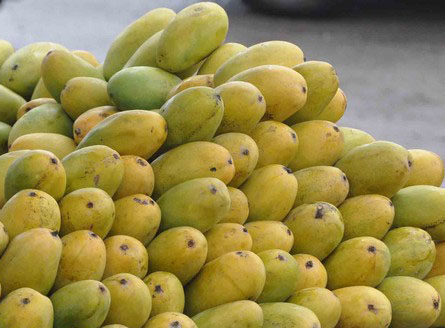Mangoes, which is the national fruit of India, holds the numero uno position when it comes to the preference of fruits among the  people of Lucknow even today. The city can be said to have been rightly nicknamed as the “city of Nawabs” on account of the Nawabi influence on the likes and choices of Lucknowites. Right from the period of the Mughals, to the Nawabs, and further during the British rule, the fruit has continued to rule the hearts of the typical Lakhnawi.
people of Lucknow even today. The city can be said to have been rightly nicknamed as the “city of Nawabs” on account of the Nawabi influence on the likes and choices of Lucknowites. Right from the period of the Mughals, to the Nawabs, and further during the British rule, the fruit has continued to rule the hearts of the typical Lakhnawi.
The Nawabs were very fond of mangoes, a fact that can be gauged by the fact that the khansamas have been reported to have prepared special sweet dishes using different varieties of mangoes every day for the Nawabs. Moreover, the gardens of the Nawabs are reported to have Dussehri and Chausa breed of mango trees.
The rich and succulent mangoes of the country, particularly Dussehri, Chausa and Langda breed of Malihabadi mangoes have had a prominent fan following both nationally and internationally. Malihabad, which is located at a distance of 28 kms from Lucknow, and the adjoining areas, constitute the world famous mango belt of the country. The Malihabadi breed of mangoes such as Dussehri, Safeda, Langda, Chausa, Tukmi, Khaas-ul-Khaas, and Lakhnawwa, are cultivated and exported across the world.
Malihabad – The Centre of Delicious Mangoes
Malihabad, a small town near Lucknow, is particularly famous for the quality of mangoes, and the pathans. A pathan named Abdul Bari Khan of Malihabad, popularly known as “Khan Saheb”, first started the grafting of mango trees to produce newer and different tasting varieties of mangoes during the 1880s. He was also one of the founding members of the Botanical Gardens in Lucknow and the Uttar Pradesh Fruit Development Board. In the year 1937, the British government awarded him the honored title of “Khan Saheb” for his valuable contribution and guidance towards the development of horticulture, particularly mangoes in and around Malihabad.
Apart from Malihabad, some adjoining places such as Rehman Khera, Kakori, Mal, Auras, Mohaan, Sandila, Atraula and Kaithan Khera, to name a few, have been the destinations for developing new varieties of mangoes. Malihabadi mangoes have also been conferred with the Geographical Indication (GI) status by the Government of India for their distinct and delicious varieties of mangoes.
Contributions of Padma Shree Haji Kaleem Ullah Khan to Mango Grafting
The legacy of mango grafting and cultivation initiated by Khan Saheb Abdul Bari Khan is beautifully being carried forward by Padma Shree Haji Kaleem Ullah Khan of Malihabad. He is also known as the “Mango Man” by the people of Lucknow and is a world renowned figure today. Haji Kaleem Ullah Khan has the unique distinction of growing 300 different varieties of mangoes on a single tree in his Abdullah Nursery, which is located in Malihabad. Kaleem Ullah Khan‘s cherished tree on which he performed this unique act is believed to be over 100 years old. He is said to have started his work on the tree in the year 1987 and it took quite a few years for him to achieve this astonishing feat.
Every mango grown on the tree has a small label of identification fastened to its green pedicle. Kaleem Ullah Khan named all the 300 mangoes differently such as Husn-e-Ara, Pukhraj,Asl-ul-Muqarrar, Himsagar, Walajah Pasand and Makkhan to name a few. Khan Saheb has also named two of the mangoes after celebrities, cricketer Sachin Tendulkar and Bollywood actress Aishwarya Rai Bachchan. Recently, he has been in news for trying to develop “Modi” mango after Narendra Modi became the Prime Minister.
In June 2012, high commissioners and ambassadors of more than 15 countries were invited to Malihabad to explore the “Ek Shaam Malihabadi Dussehri Ke Naam” event, hosted by the Mango Growers Association of India. The idea was to promote the mangoes of Malihabad, especially Dussehri to other parts of the world. Kaleem Ullah Khan presented some of the saplings of mangoes to the ambassadors at the event and requested them to grow the seedlings in their country.
Central Institute for Subtropical Horticulture
The Central Institute for Subtropical Horticulture located on Lucknow-Hardoi highway between Lucknow and Malihabad also plays an essential role in the proper preservation, grafting and cultivation of different varieties of mangoes. The institute is also known as Rehman Khera Farm by the people of Lucknow. The institute is spread over an area of 132.5 hectares with state-of-the-art facilities for scientists and researchers to conduct scientific examinations on saplings of mangoes and other subtropical fruits.
Extensive research on the proper preservation and cultivation of mangoes carried out at the institute has actually assisted the mango growers of Malihabad and other mango growing belts of the state. Improved pesticides, fertilizers and compost provided by the institute have helped the mango growers of the state to a great extent.
The Lure of the Mangoes of Lucknow
The lure of juicy and flavorful dussehri, safeda, chausa and langda varieties continues even today. The charm of these mouthwatering mango varieties will never fade in the hearts of the true Lucknowitess. Sincere efforts by the government have really helped in exporting varieties of mangoes, particularly the famed Dussehri to other parts of the world.
The King of Fruits “Mango” becomes the first choice of Lakhnawi people when it comes to fruits as soon as the mango season starts in April-May, such is the adulation and preference it gets from the people of Lucknow.


Comment here